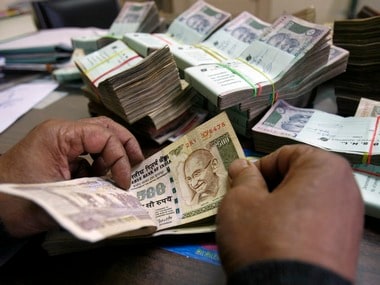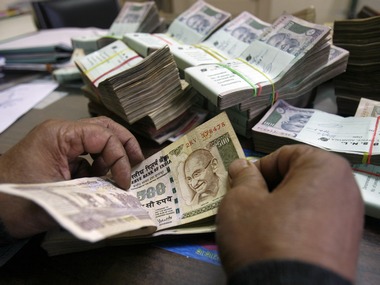Drawing up a budget that satisfies all the constituents of the economy is difficult, if not impossible. This is because a lot of expectations are built before the budget is presented virtually making an ‘income and expenditure’ statement the ‘be all and end all’. But practically looking at a budget, there are serious limitations on what it can do. The revenue is based on how the economy performs and the expenditure has to be tuned according to the revenue when we are mindful of the fiscal deficit. A budget size of Rs 17.9 lakh crore has a fixed component of interest and defence payments which aggregate top Rs 7 lakh crore. This means there is flexibility with Rs 10-11 lakh crore out of the GDP of Rs 141 lakh crore for FY16. The challenge is how you make this 7 percent of GDP effective?[caption id=“attachment_2125433” align=“alignleft” width=“380”]  Tax calculation. Reuters[/caption] A problem which our budgets confront is one of credibility; and the fault is not with the government but sheer bad luck. For example, gross tax revenues were to be Rs 13.6 lakh crore in FY15 but came lower at Rs 12.5 lakh crore. Hence there was a slippage of 8 percent. For the current year, we are targeting Rs 14.49 lakh crore which is quite bold considering that we expect GDP in nominal terms to grow by 11.5 percent only. This means that the elasticity of tax revenue has to be above one, which can be tough if the economy does not grow on the desired path. Similarly it has become axiomatic to build aggressive disinvestment targets which were Rs 63,000 cr last year of which around half has come through. Yet we are looking at Rs 69,500 crore for FY16. The issue really is that if these numbers do not materialize and we have the interest plus defence expenditure that cannot be compromised, then we have to cut back on investment to balance the budget. The size of the Budget was targeted at Rs 17.9 lakh crore last year, but the revised number is a shrunken Rs 16.8 lakh crore. Given this background which serves as limitations for any government, how can one view the budget for FY16? First, we are assuming growth in nominal GDP at 11.5 percent, which going by the Economic Survey forecast of 8-8.5 percent in real GDP implies a deflator of 3-3.5 percent, which is aggressive. We have rarely had such low inflation numbers, though assuredly in case the number is higher, then tax revenue will also benefit. Therefore, there can be good news of higher revenue or lower deficit ratio if the GDP growth rate is higher than 11.5 percent. Second, the speech talks a lot of investment and the sense is that the government is doing a lot here. But a closer look reveals that while total capital expenditure under plan and non-plan categories was budgeted at Rs 2.26 lakh crore in FY15 the revised estimates came down to Rs 1.91 lakh crore, which means that there was a cut of Rs 35,000 cr. Now with the target of Rs 2.41 lakh crore for FY16, we are actually adding Rs 50,000 cr which is also equivalent to the difference between the 3.6 percent and 3.9 percent fiscal deficit numbers. Third, while there is some investment push, we do not see any the same with consumption. The consumer goods industry has been in jeopardy for three years now as consumers are not spending ostensibly as their incomes have not increased with inflation. There have been no concessions offered here which means that consumption per se is unlikely to increase on account of the budget provisions. The only indirect route would be through the maintenance of the NREGA programme which will hopefully increase the wages paid, which can in turn lead to higher spending. But, one cannot be sure of how this will work out. Fourth, savings can get a push as the government has offered tax exemptions for money saved in pensions and insurance. It is uncertain whether there will be new policies taken or deposits made, or will the existing customers who were putting more money anyway receive this benefit. Health insurance is not too popular in India as people normally assume that they will not require it. Those who take it would take cover based on the amount they look at and not probably the tax limit. But, this can still be positive for savings. Fifth, the fiscal deficit has been placed at 3.9 percent instead of 3.6 percent which was expected. The government has clearly gone for additional spending, which as mentioned earlier matches the capital expenditure. Therefore, this can be interpreted as the Keynesian push. Sixth, foreign investors would be relieved with GAAR being deferred by two years. This has been a concern for investors and the flip flop on this issue could have deterred investors. With this deferment, there is more clarity and hopefully, should be received positively by the market. Sixth, the aggressive targets on disinvestment again as well as spectrum sale would draw some element of skepticism as our experiences in the past have not always been very positive. This combination is to get in above Rs 1 lakh crore which if achieved would be good, but if not, then it could be just going back to the ‘capex cut syndrome’ which is experienced at the end of the year. Seventh, to the credit of the budget there has been no cut in the subsidy amount on food, which is refreshing given that it was expected that there would be lower coverage under the Food Security Act which would cut the allocation. However, the government appears to keen on ensuring that the subsidy works better though the direct benefit transfer system and Jan Dhan account rather than reducing the coverage. This is definitely good news. Related to the food subsidy is the fuel subsidy which has come down. A thought here is that while the savings of a little over Rs 30,000 cr has been used for other purposes, given the critical nature of oil prices, it could have been worth experimenting with the creation of a fuel buffer which can be dipped into once the price moves up and pressurizes our subsidy expense. Evaluating the budget is always a tricky job and ideally one should score the earlier budget based on realization versus budgeted numbers. One can always be bold when targeting revenue or expenditure, but if at the end of the day, things do not work out, the analysis done the previous year goes awry. The present one looks conservative on the whole with no shocking measures though there would still be uneasiness on tax revenue earnings, disinvestment, spectrum sale and actual capex by the government. This can be judged better on February 2016. The author is Chief Economist, CARE Ratings. These views are personal.
Evaluating the budget is always a tricky job and ideally one should score the earlier budget based on realization versus budgeted numbers.
Advertisement
End of Article
Written by Madan Sabnavis
Madan Sabnavis is Chief Economist at CARE Ratings. see more


)

)
)
)
)
)
)
)
)



